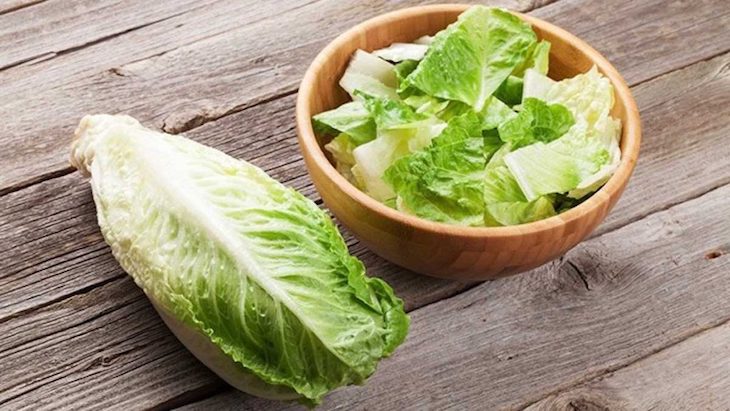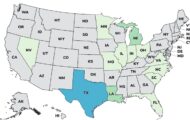In the past few years, there have been quite a few food poisoning outbreaks linked to romaine lettuce. Why is this product the source for hundreds of serious illnesses? And why are there so many E. coli outbreaks linked to romaine?

The answer lies in three facts: It’s very difficult to clean a product that is so delicate and has so many crenelations and areas for bacteria to hide. Second, produce is a raw product and is often eaten without a kill step to destroy pathogens. And third, because leafy greens including romaine grow on the ground and are subject to contamination through irrigation water and animals, and are handled so often between farm to fork, there are many opportunities for contamination.
Romaine is difficult to clean
Romaine lettuce, along with other leafy greens, is difficult to clean simply because of the nature of these products. Bacteria love to hide in crevices, and can, in fact, produce biofilms that protect them from water, soaps, and disinfectants. And if there are any tiny rips or tears in the leaves, bacteria will take advantage of that and get inside the leaf, where they can’t be removed with any method.
Consumers are encouraged to rinse loose leafy greens thoroughly, but it’s impossible to remove all pathogens from these products. And it only takes 10 E. coli bacteria to make someone very sick. The only way to definitively kill pathogens on food is to heat them through cooking.
In fact, during one of the romaine E. coli O157:H7 outbreaks last year, government warned consumers not to eat ANY romaine lettuce at all because of the nature of this leafy green and the fact that officials weren’t sure where the contaminated romaine was grown and harvested.
Produce is a raw product
Produce is one of the most common sources of foodborne illness pathogens. Any raw product can be contaminated with bacteria, but raw produce is more likely to carry bacteria because animals and birds can, quite literally, poop on the fruits and veggies. That’s just a fact of life.
In a report by the Centers for Disease Control and Prevention released in September 2019, there were 32 multistate outbreaks linked to food in 2017. Of the 25 outbreaks linked to a single category of food, vegetable row crops such as leafy greens were the cause of five of those outbreaks. This was before the outbreaks linked to romaine lettuce in 2018 and 2019.

Food safety attorney Fred Pritzker said, “growers and processors of leafy greens must be very careful about how they handle these potentially contaminated products.” You can contact Fred for help by calling 1-888-377-8900 or 612-338-0202.
And because of our modern food processing and transportation system, one head of romaine lettuce growing in Arizona or California can contaminate a huge batch of salads. That means that, unlike in the past, a person living in Wisconsin or Illinois can acquire an E. coli O157 infection because a head of romaine lettuce grown in Yuma Valley, Arizona was contaminated and included in the salad they ate.
Produce is easily contaminated
Think about how leafy greens are grown. They are grown right on the ground, in huge fields, exposed to any animal that may run through the field or bird that flies overhead. The potential for contamination is everywhere.
In addition, dirty agricultural water used for irrigation and runoff from nearby farms can, and have, deposited E. coli bacteria and other pathogens onto the greens. Concentrated animal feeding operations (CAFOs) are a particular problem for greens simply because of the large amounts of manure they produce that can contaminate canals, streams, and rivers.
Regulations specify buffer zones between produce fields and CAFOs, but that amount, 400 feet, apparently wasn’t enough in the recent outbreaks. The California Leafy Green Marketing Agreement group tripled the buffer zone to 1200 feet after the outbreaks in 2018 and this year, in addition to requesting more testing of irrigation water.
Then, the greens are harvested, sent to central processing centers, often cut or otherwise manipulated, packed into bags, and sent all over the country. One dirty shipping container, one person in the field who is sick, or one piece of processing equipment that isn’t properly cleaned can cause what is called cross-contamination.
In the past 2 years, these are the food poisoning outbreaks linked to or possibly associated with romaine lettuce and leafy greens:
- An E. coli O157:H7 outbreak in Maryland has sickened at least 7 people. They all ate Ready Pac Bistro® Bowl Chicken Caesar Salad sold at Sam’s Club before they got sick. Officials found E. coli O157 bacteria in the romaine lettuce in an unopened package of that product.
- A possible E. coli O157 outbreak was just identified in Wisconsin through information posted on ProMED-mail. Three women have presented with symptoms of an E. coli infection; they told their doctors they ate lots of salads before getting sick. Sources now say there may be as many as 9 people sick.
- A secret E. coli O157:H7 outbreak linked to romaine sickened 23 people in 12 states this year. The FDA didn’t release any information about this outbreak until it was long over.
- An E. coli O157:H7 romaine outbreak during the fall and early winter of 2018 sickened at least 62 people in 16 states. Twenty-five people were hospitalized, and two developed hemolytic uremic syndrome (HUS), a type of kidney failure.
- A huge E. coli O157:H7 romaine outbreak ended in June 2018. At least 210 people were sickened in that outbreak. Ninety-six people were hospitalized, 27 developed HUS, and five people died. In this outbreak, officials discovered that runoff from a large CAFO got into canal water that was used to irrigate the romaine lettuce fields and may have been the pathogen source.
- A huge cyclospora outbreak in 2018 was linked to Fresh Express romaine and carrot mix used to make McDonald’s salads. At least 511 people in 16 states were sickened.
What can you do?
Leafy greens, including romaine lettuce, are part of a healthy diet. These products provide lots of vitamins and minerals and are a great source of fiber. Don’t avoid them because they may be contaminated.
But, if you or someone in your family are in a high risk group for serious complications from food poisoning, which include the elderly, pregnant women, children, and anyone with a chronic illness or compromised immune system, think about cooking your greens. Romaine is a sturdy green and can be cooked, as can kale, mustard greens, and others. Cooked greens are safest to eat.
If you buy romaine that has been bagged into a salad mix, don’t try to rewash it. This sounds counter-intuitive, but there’s a greater chance that the greens will be contaminated in your kitchen sink than they were in the processing center. If you buy loose greens, wash them thoroughly. Rinse well under cool running water and then dry with paper towels; this can help remove pathogens.
Finally, pay attention to recalls of all products, but particularly leafy greens such as romaine, and other raw produce. Food Poisoning Bulletin posts all food recalls from the FDA and USDA.





You can get kidney failure from contaminated food. My son & his cousin both got kidney failure at same time. They fished & camped on weekends. Always took beef (steaks) with them & some was probably contaminated w/ E-coli. They kept it in the cooler with their drinks. My son is on his 21st year of dialysis & his cousin died 2 years ago after 18 years on dialysis. It’s a HARD, HARD life! Years ago, I read a true story in Good Housekeeping of a family who ate pre-washed greens. Every member of family that ate the salad got very ill & kidney failure. The toddler went blind. They later found out that even tho the salad said “tripled-washed”, the water was contaminated with run-off from a nearby cattle farm or dairy – E-coli. (Be careful! – Hope this info will help someone!)
I’m so sorry for your loss. Yes, Shiga toxin-producing E. coli bacteria is a terrible pathogen. HUS, the complication of an E. coli infection, can change someone’s life.